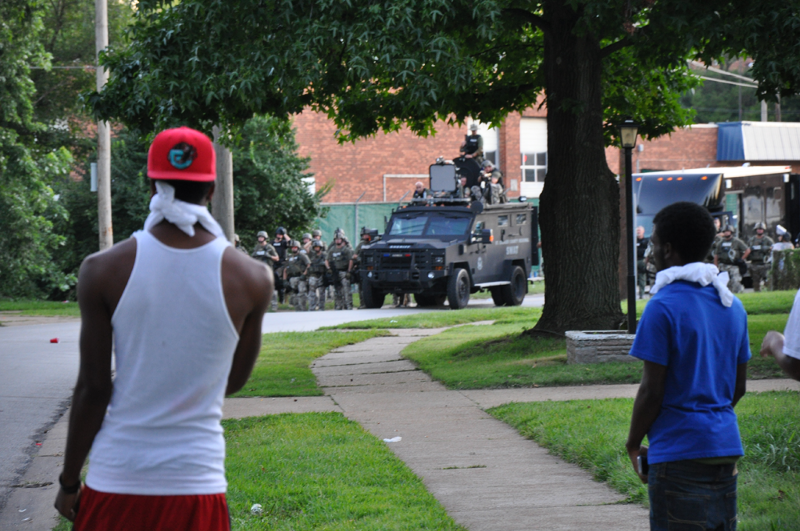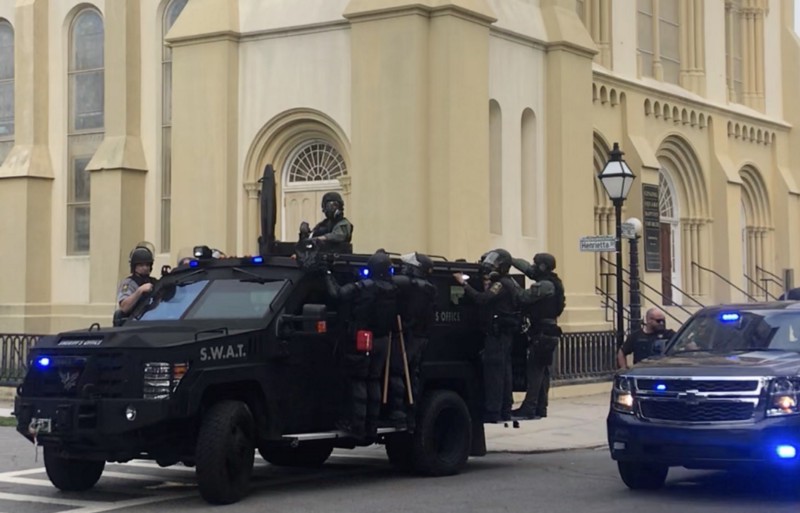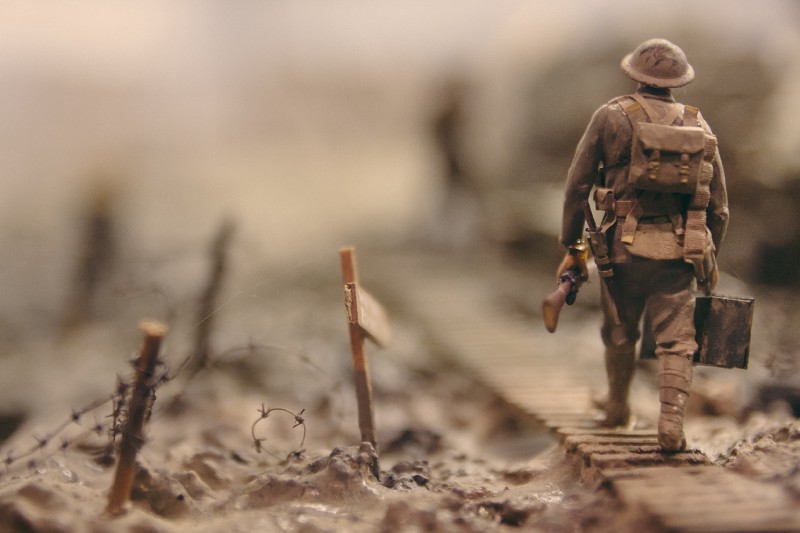Discover how police militarization is a key component of police violence in the United States and around the world.
by Taylor O’Connor | 20 July 2020

“What the main drift of the twentieth century has revealed is that the (US) economy has become concentrated and incorporated in the great hierarchies, the military has become enlarged and decisive to the shape of the entire economic structure; and moreover the economic and the military have become structurally and deeply interrelated, as the economy has become a seemingly permanent war economy; and military men and policies have increasingly penetrated the corporate economy.” — C. Wright Mills (in The Power Elite, 1956)
I wrote this article for the United States context. Themes covered and action points at the end can be applied more broadly elsewhere.
I watched with deep concern the quick and often brutal police response to peaceful protests that swept the nation in the wake of George Floyd’s murder by Minneapolis Police.
So many videos of violent police responses to peaceful protesters have been circulating on Twitter that activists created a public online spreadsheet to track it all, clocking in over 500 videos in less than three weeks!!! The violence was and continues to be so widespread, Amnesty International got involved, investigating 125 selected incidents nationwide to further highlight the deeply rooted, systemic nature of police violence in America.
But beyond the violence itself, it was the visuals of heavily militarized police that were so striking. When you’re protesting peacefully to bring attention to systemic police violence, and your local police department shows up looking like they are about to launch a major offensive on Fallujah, something is terribly wrong.
And when police violently attack peaceful protesters simultaneously, for weeks on end in cities and towns across the nation, there is no grounds for the argument that it’s just a few ‘bad apples.’ That we’ve been militarizing our local police nationwide for decades has made widespread police violence inevitable.
The arsenal in your local police department, courtesy of the Pentagon
As if the helmets, body armor, ‘less-lethal weaponry,’ and masks weren’t enough, we’re seeing units backed an assortment of armored vehicles and combat-ready officers toting assault rifles. Of course, all this is going on whilst doctors and nurses on the front lines of the COVID-19 pandemic have been wrapping themselves in garbage bags because the protective gear they desperately need was in short supply.

Look at robocop over here. He’s the guy they sent out to convince us all that police violence isn’t a problem. “Everything is fine. We’re just here to keep you safe. Now everybody go back home and go about your normal business before I plant one of these ‘less-lethal’ projectiles into your face.” I’m not convinced.
But this is not a new problem. We’ve seen this before. Remember Ferguson?
It has been nearly six years since local police rolled down streets of Ferguson in heavily armored vehicles with mounted snipers, and where officers in military-style body armor and urban camouflage stormed the streets menacing protesters with automatic rifles.

You may have thought that this issue was dealt with then, but in reality, local law enforcement agencies across the country are even more heavily militarized than during Ferguson.
And while the campaign to defund the police has been useful in starting a conversation and will inevitably lead to some tangible results, this alone won’t rid us of super-soldier policing. You see, local police departments need not pay for the military equipment they own. The Pentagon takes care of that. All that great military equipment developed and used for massive counter-insurgency campaigns abroad has found a happy home in your neighborhood police department.
If you want to see what military vehicles, weaponry, and other equipment your local police department has in its arsenal, this information is required by law to be publicly available. It is updated quarterly, and you can look it up the compiled list HERE, or find the raw data HERE.
I looked up the police department in my hometown and sheriff department that covers the county my hometown is in. And so, I’m wondering what the actual fu*k they are doing with over 600 military-grade assault rifles, various types of armored trucks, and numerous military ‘utility’ helicopters. Also, of course, they’ve got bayonets, grenade launchers, sniper rifles, and all kinds of other battlefield-ready weaponry. And what is a ‘combat/assault/tactical wheeled vehicle’? We’ve got one of these. Plus, two truck mounts. So naturally, I’m wondering what kind of weaponry they’ve got mounted on their armored vehicles.
Nowhere in the nation should local police own, less use, military equipment designed for the battlefield. It’s no wonder the killing of innocent civilians by police in America far exceeds that of any other developed nation. To find out how one might go about taking all this military gear away from the them, I had to do some research about how local police (and sheriff) got their hands on all this sh*t in the first place.
How local police departments obtain military-style equipment
Under the auspices of the ‘War on Drugs,’ in the 1990s, the Department of Defense began providing excess military weaponry, vehicles, and gear to local police and sheriff departments around the country. While law enforcement agencies can obtain free military equipment from multiple federal government programs, most of this takes place via the federal government’s 1033 Program.
The Defense Logistics Agency (DLA) responsible for the program describes its mission as ‘disposing of obsolete/unneeded excess property turned in by U.S. military units around the world.’ So basically, we’re producing so much excess military gear that we’ve been offloading it on our local police departments since the 90s. And the quantity of transfers increased sharply following 9/11 as the ‘War on Terror’ became the new justification police departments took to stockpile military equipment.
So as of June 2020, there are around 8,200 federal, state, and local law enforcement agencies from 49 states and four U.S. territories participating in the program. And according to DLA, to date, about $7.4 billion in military equipment and gear has been transferred to law enforcement agencies around the country since the program began. Again, that’s assault rifles, grenade launchers, armored/weaponized vehicles and aircraft, drones, body armor, and the like. All equipment is free. Local police departments need only pay for delivery and storage, and there is little oversight for how they use the toys they receive.
In the fallout from Ferguson, then-president Obama put some restrictions on weaponized vehicles and aircraft, grenade launchers, and other types of weaponry you’d only see on a battlefield. While such gear was only the tip of the iceberg, these restrictions were later revoked by President Trump’s executive order, and the range of equipment available expanded.
How local police use military-style equipment
The military weaponry and equipment transferred to local police and sheriff departments around the country is primarily (though not exclusively) used by Special Weapons and Tactics teams (i.e., SWAT teams). SWAT teams were created to respond to hostage, active shooter, and other ‘emergency situations,’ but in reality are mostly deployed in routine policing activities.
A 2014 report by the ACLU found that SWAT teams were most often deployed — unnecessarily and aggressively — to execute search warrants in low-level drug investigations. Analyzing more than 800 SWAT deployments conducted by 20 law enforcement agencies, only 7% of deployments were for “hostage, barricade, or active shooter scenarios” (i.e., the stated purpose of SWAT teams, and their only justification for having military-grade equipment).
So since police departments are so accustomed to using SWAT teams all jacked up with military gear for whatever random and unnecessary task is needed, they have no qualms about deploying them at protests today. Check out these guys enforcing curfew on protesters in Charleston County, South Carolina.

The ACLU report describes how SWAT raids in themselves are excessively violent events regularly carried out by 20 or more officers armed with assault rifles approaching a home in the dark of night. They often deploy explosive devices, they bust down doors and break windows, and they storm in with guns drawn and locked on targets screaming for the people inside to get on the floor.
Corroborating common knowledge about systemic racism in policing, the ACLU found that such raids primarily target people of color and that extreme racial disparities are commonly seen in how SWAT teams are used by local police nationwide. It doesn’t take a rocket scientist to understand that when police are kitted out with all kinds of battlefield ready weaponry and deploy military tactics, casualties are high.
For a recent example, one only need to look at the wrongful death of Brionna Taylor. Louisville police officers fired more than 20 rounds into Taylor’s apartment while issuing a ‘no-knock’ warrant (at the wrong house) for petty drug offenses. The Louisville Metro Police department has received over $800,000 worth of military vehicles and equipment since the 1033 Program began.
How to demilitarize policing in your community, and across the nation
Now you know what weaponry our local police department has in its arsenal. You know how they got it. How about taking it away from them?
Below are some practical actions that you can take to demilitarize police in your community or nationwide.
1. Advocate for State, city, or local policies to demilitarize the police in your city or town.
While the 1033 Program and other similar programs are all federal programs, it is possible for your state, county, city, or local authorities to put restrictions on what equipment local police departments have and how they use it. Indeed, equipment transfer requests from your local police department must be formally approved by local governing bodies (city council, mayor, etc.), and ‘local governing bodies’ have oversight on equipment transferred.
Hold your leaders to account. Establish local policies to prevent police departments from purchasing military equipment and make them return of equipment they already have.
Local policies can also limit the use of existing weaponry explicitly for hostage, active shooter, barricade, or other emergency situations where lives are indeed in danger. Local laws can be made to ensure the use of such equipment requires approval from high-ranking officials. Advocate for local policies to limit the use of existing weaponry.
2. Advocate for an end the Federal Government’s 1033 Program and other related programs.
Congress authorized the Department of Defense to make excess military equipment available to law enforcement back in 1990. And the Congress itself periodically introduces and passes legislation affecting the 1033 Program and other similar programs. Both the President and Congress have the power to end the 1033 Program and further to abolish the practice of transferring military equipment to local law enforcement agencies.
3. Advocate for a demilitarization of the federal budget.
Our economy produces mass amounts of taxpayer-funded military equipment to fuel large-scale military campaigns abroad, an ever-expanding military presence overseas, and, in turn, the militarization of your local police. More than half of funds allocated by Congress every year (i.e., discretionary spending) goes directly to military spending. And much of that ends up in the pockets of companies producing weapons of war, many of which end up on the streets of America.
And as federal military spending is continually increasing, so too expands our military presence around the world, and more weaponry gets offloaded onto local police departments.
Don’t just advocate to end a particular war, address the core of the issue: taxpayer-funded hyper-militarization. Constrict the supply of weapons to the war-machine, and the Pentagon will stop offloading excess military equipment on local police departments. Advocate for Congress to realign our federal spending to care for needs of local communities. Elect leaders that advocate for not only an end to foreign wars, but also demilitarization of federal spending.
4. Expose those who profit from war/militarization at home and abroad.
While companies that produce weapons of war only profit when we are in a war or when war is on the horizon, so too they profit by equipping local police for combat. The vastly powerful companies that dominate weapons production receive billions in taxpayer funds and have enormous lobbying power across the political spectrum. Mobilize against companies that produce these weapons of war. They must not be the ones that dictate our foreign policy. And expose the politicians who receive payouts from the weapons lobbyists like the NRA.
5. Discredit the myth that military equipment is needed in law enforcement
Powerful interests are behind the militarization of police and these will be your main obstacle. When someone with a badge or in a suit stands up and explains calmly the need for such weaponry, stressing that it will be used only protect innocent lives in ‘emergency situations,’ we know this is a lie. We know that these weapons are seldom used for the purposes claimed, and we know how these weapons only heighten police violence, particularly targeting communities of color. Your ability to make this argument will be instrumental to your success in demilitarizing the police.
6. Challenge the ideology of patriotism
Patriotism is the go-to rallying cry for war, and it is the veil used to conceal systemic racism in policing. Philosopher Leo Tolstoy wrote that “to destroy governmental violence, only one thing is needed: It is that people should understand that the feeling of patriotism, which alone supports that instrument of violence, is a rude, harmful, disgraceful, and bad feeling, and, above all, is immoral.”
If you gain any momentum for change, the patriotism card will be drawn by those who profit from militarization or otherwise benefit from it. They will feign outrage at the very thought of criticizing military or police institutions, however unjust they be.
Those amongst the general public who are drawn to feelings of patriotism are blind from recognizing injustice when it is staring them in the face in the bright of day. The greater your ability to dismantle the ideology of patriotism, the greater will be your ability to demilitarize police, be it in your local community or nationwide.
If you found this article helpful and want to find more blog posts like this mapping organizations that build peace across a wide array of themes be sure to check out our Resources page!
And be sure to sign up for our newsletter (the best peacebuilding newsletter out there!) to get connected with all the best articles, videos, podcast episodes, events, downloads, learning opportunities, and other resources on building peace published each week, selected from a broad array of global efforts to build peace. Subscribe by clicking HERE.



